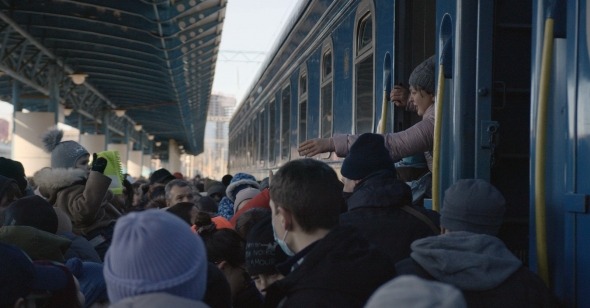Where There's a Will
By Chris Cassingham
Songs of Slow Burning Earth
Dir. Olha Zhurba, Ukraine, no distributor
In Songs of Slow Burning Earth, Ukrainian filmmaker Olha Zhurba doesn’t tell the story of her country’s war on the level of military strategy or political maneuvers. Nor does she follow one character or family trying to escape violence. Her approach is in contrast to two notable Ukranian war documentaries from the last two years, Mytsylav Chernov’s 20 Days in Mariupol and Maciek Hamela’s In the Rearview; the former an account of Russia’s invasion as it's happening, the latter exploring the breadth of Ukraine’s trauma in just a single location. In her approach, Zhurba and her three cinematographers (Volodymyr Usyk, Viacheslav Tsvietkov, and Mykhailo Liubarski) affix their keenly observant cameras on details of human behavior in extremis. The result is less a collective narrative of the ongoing war than a collage of impressions and feelings that guide the viewer across geographical terrain and reveal a country’s citizens processing their trauma in wildly different ways.
Zhurba’s detached gaze prizes people’s movement, or lack thereof, in the frame. At a train station, amongst the crush of would-be passengers desperate to escape, adults argue over who should board first. Zhurba cuts from the melee to a terminal packed with stalled travelers while a voice announces new train cancellations. In these moments a bored teenager playing on her iPad and a young boy being shoved into a train car are equal representations of Ukraine’s unfolding nightmare.
Other details lay bare the psychological toll of being quickly uprooted. A caravan of evacuees haulted 29 kilometers from the frontline (indicated, as with most other new locations in the film, via on-screen text); an elderly woman lamenting the abandonment of her home of 70 years in Mariupol, having had to escape in her bathrobe. This woman becomes something of a Pa Joad figure in this saga, the obstinate old-timer in need of reassurance from her granddaughter that a home is defined by its people, not its walls or material possessions. Her grief bears the same heart-wrenching weight as the small boy getting his hands washed with disinfecting wipes after exiting a crowded van, his angelic, serene face belying incomprehensible fear.
The granddaughter’s optimism finds echoes in other sequences. At a state school 906 kilometers from the frontline, children talk about their dreams and draw them on handheld blackboards. One girl hopes to earn her black belt in karate, another for victory for Ukraine. That they’re tasked with visualizing those desires through a medium as brittle and impermanent as chalk seems inadvertently cruel. Elsewhere, much closer to the frontlines, a bombed-out small town is a husk of its former self. Nevertheless, it teems with a retaliatory energy. Defiant young boys roam the empty, pockmarked streets, improvising military drills against an invisible Russian enemy. It’s only when a real war plane flies past their heads that they, and their performative bravery, disappear behind what few structures are left standing.
While routines like school and work are no longer normal, rituals remain. Workers at a bread factory 18 kilometers from the frontlines continue production, their loaves travelling down the assembly line like little soldiers preparing for deployment. Even as Russia tears Ukraine apart, there is an urgency to ensure the country lives up to its name as “the breadbasket of Europe.” Hungry people line up behind a van full of fresh loaves. Who among them will be called up to the line of duty? One worker implores a man waiting for his bread, “Take the aid and quickly run away.” Zhurba also departs from this scene, cutting to a shot of scorched wheat on a muddy field, a rare insistent symbol in a film of marked restraint.
Songs' centerpiece sequence begins inconspicuously. Through a dashboard-mounted camera we watch as a truck trundles along a country road. It’s a cold winter’s day; snow dots the ground. The houses along the road help funnel the truck into the center of town, as do the people who suddenly materialize to kneel on the ground and bow their heads; are they praying, surrendering, honoring? Seen in such small numbers, their somber gestures feel more like quirks, easy to dismiss, until more join in; farmhouses give way to a dense village and the people, once a smattering, are an unbroken chain of hundreds, kneeling at the feet of some as-yet-unseen presence that Zhurba forces the viewer to embody. It’s another kind of ritual, though one the kneelers had never planned or hoped to perform. Soon the mass makes its way to a hillside church, bells tolling as a line of men with rifles salute with synchronized skyward shots the fallen soldier the passing truck has finally borne home.
Four hundred and fourteen kilometers from the frontline, joyous demonstrators detach an emblem of the hammer and sickle from the Motherland Monument. One participant proclaims the occasion historic; “It’s great that we’re finally getting rid of Soviet symbols like these,” she says, as onlookers take pictures of, and a small news crew documents, the giant metal crest on the ground. The collective relief from this burden permits a young child to roll down a grassy hill carefree, for a handful of sunbathers to decompress by a lake. At another school, teachers ask their students what they would be willing to do to secure the future Ukraine deserves; their voices cut out before we hear an answer. Cut to a Central Russian state school—3,643 kilometers from the frontline, yet somehow ominously close. Children don’t talk of dreams, don’t draw pictures; faceless, washed of agency, they march like soldiers and chant in unison. This is what Russia is willing to do.
